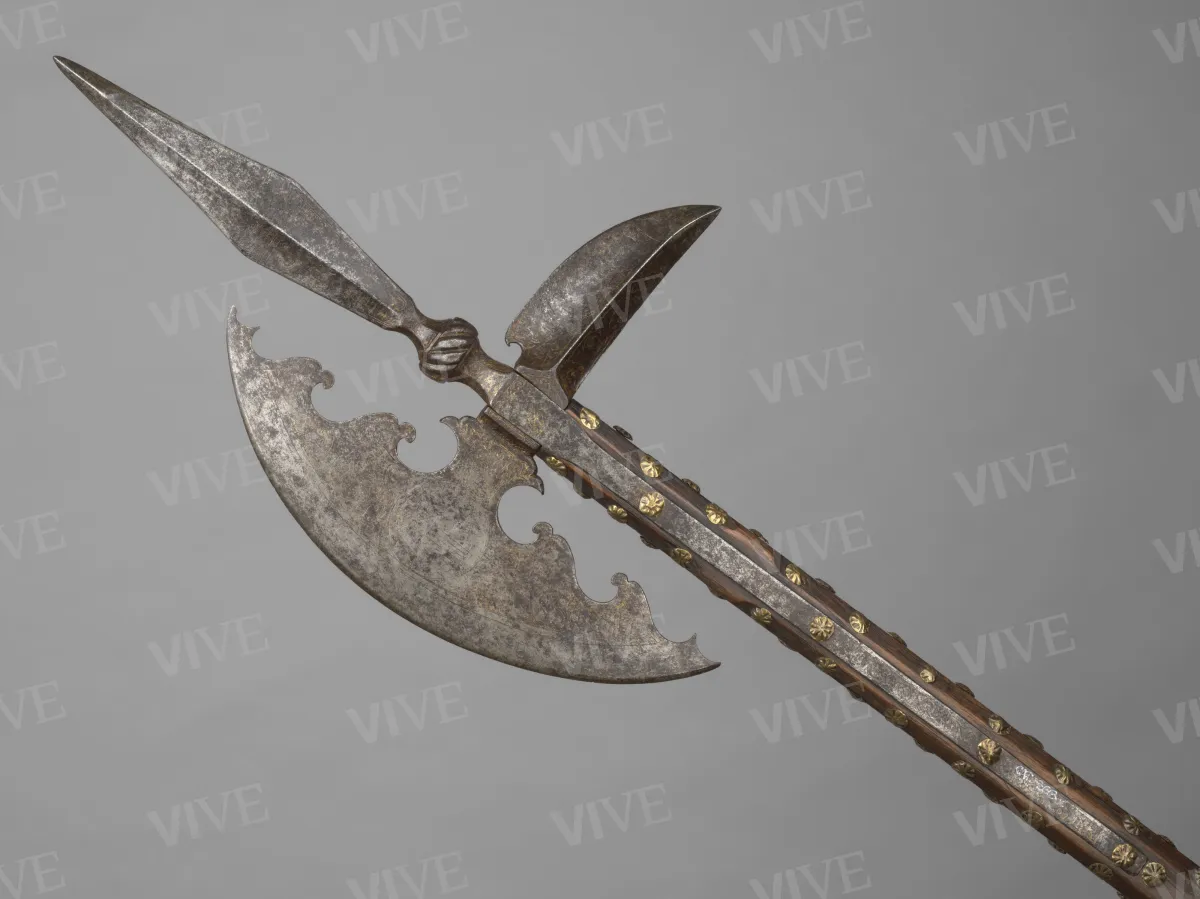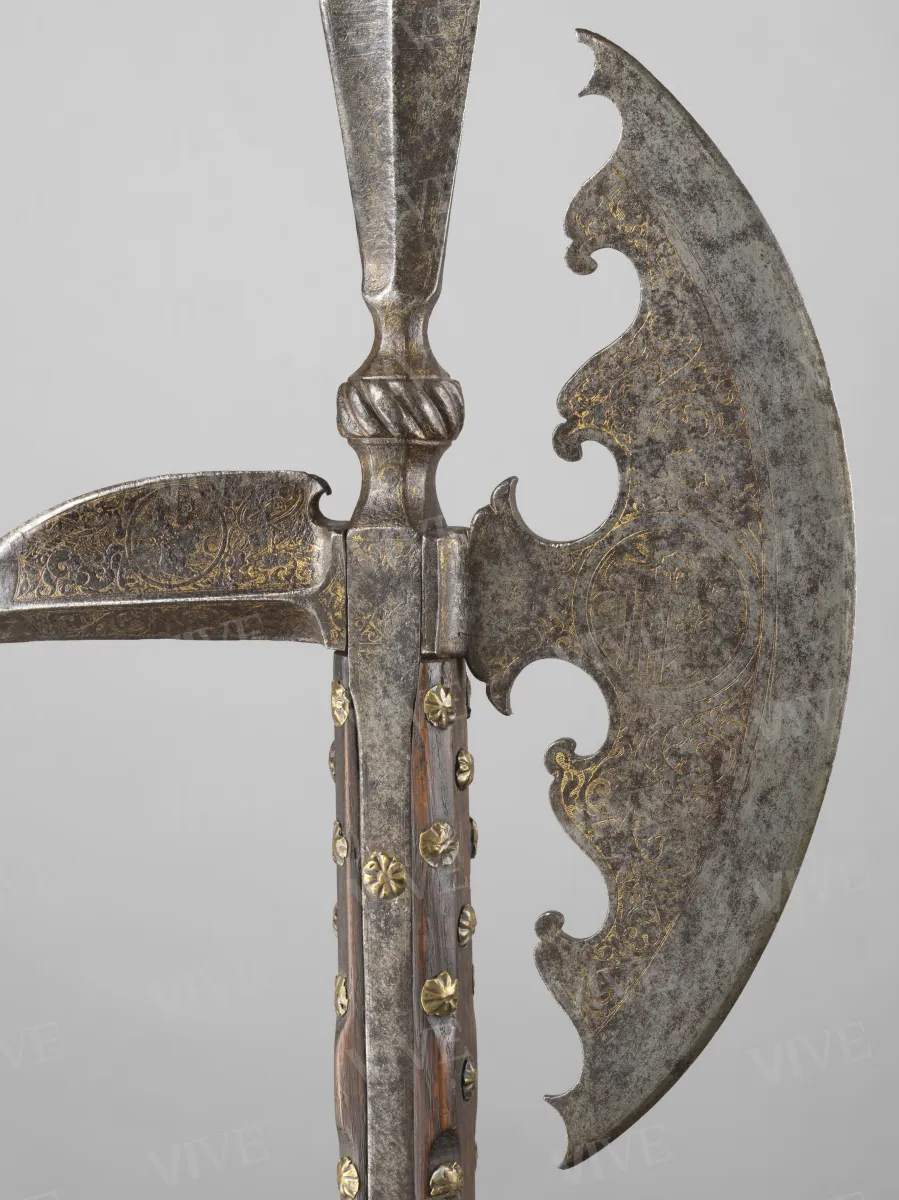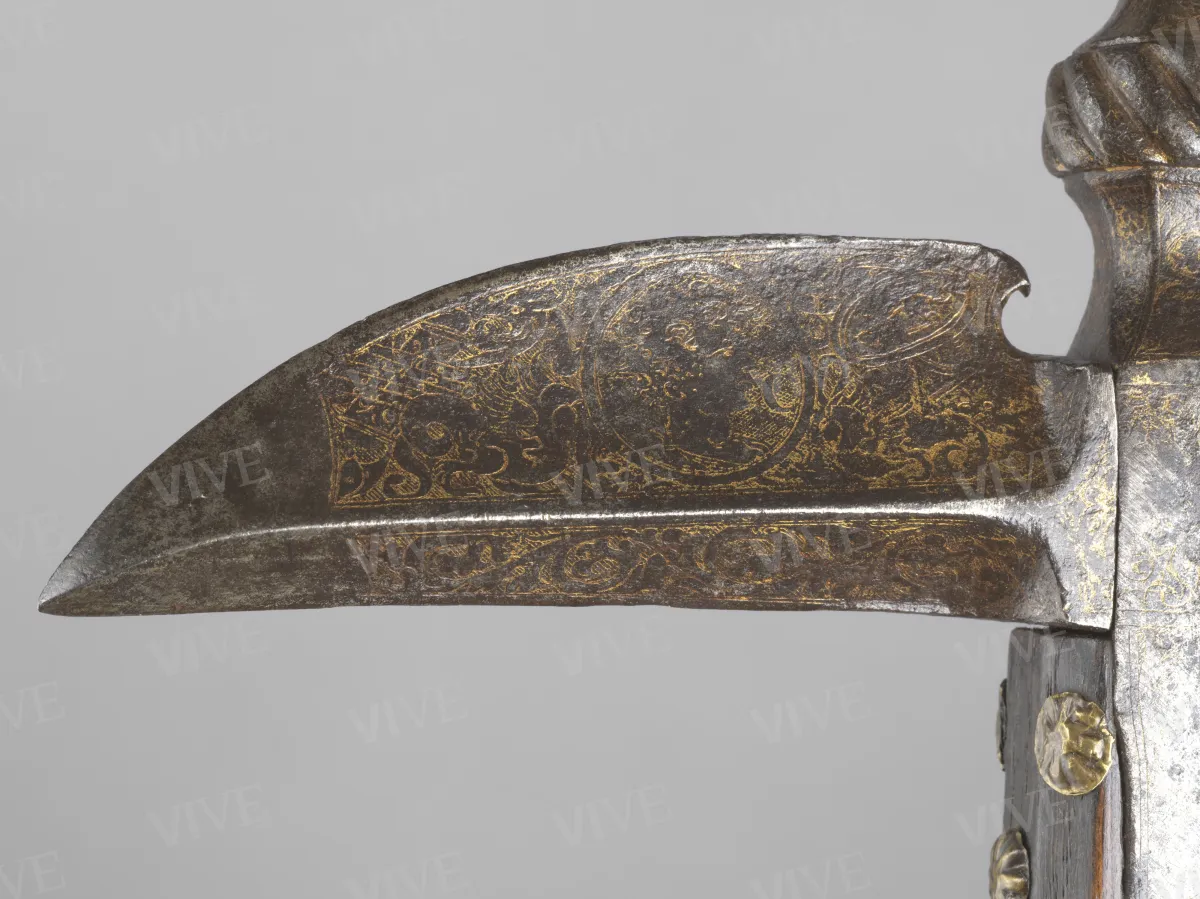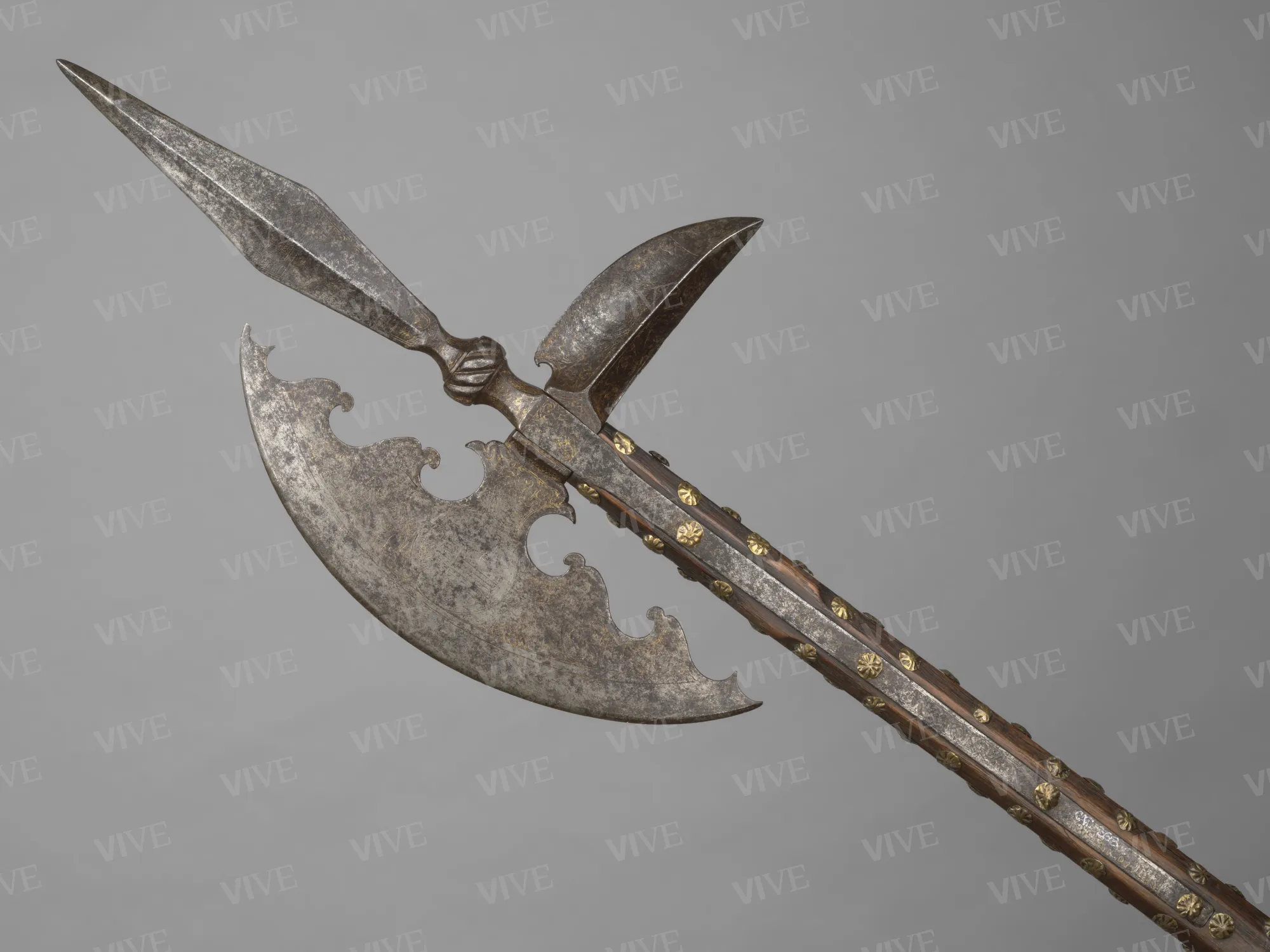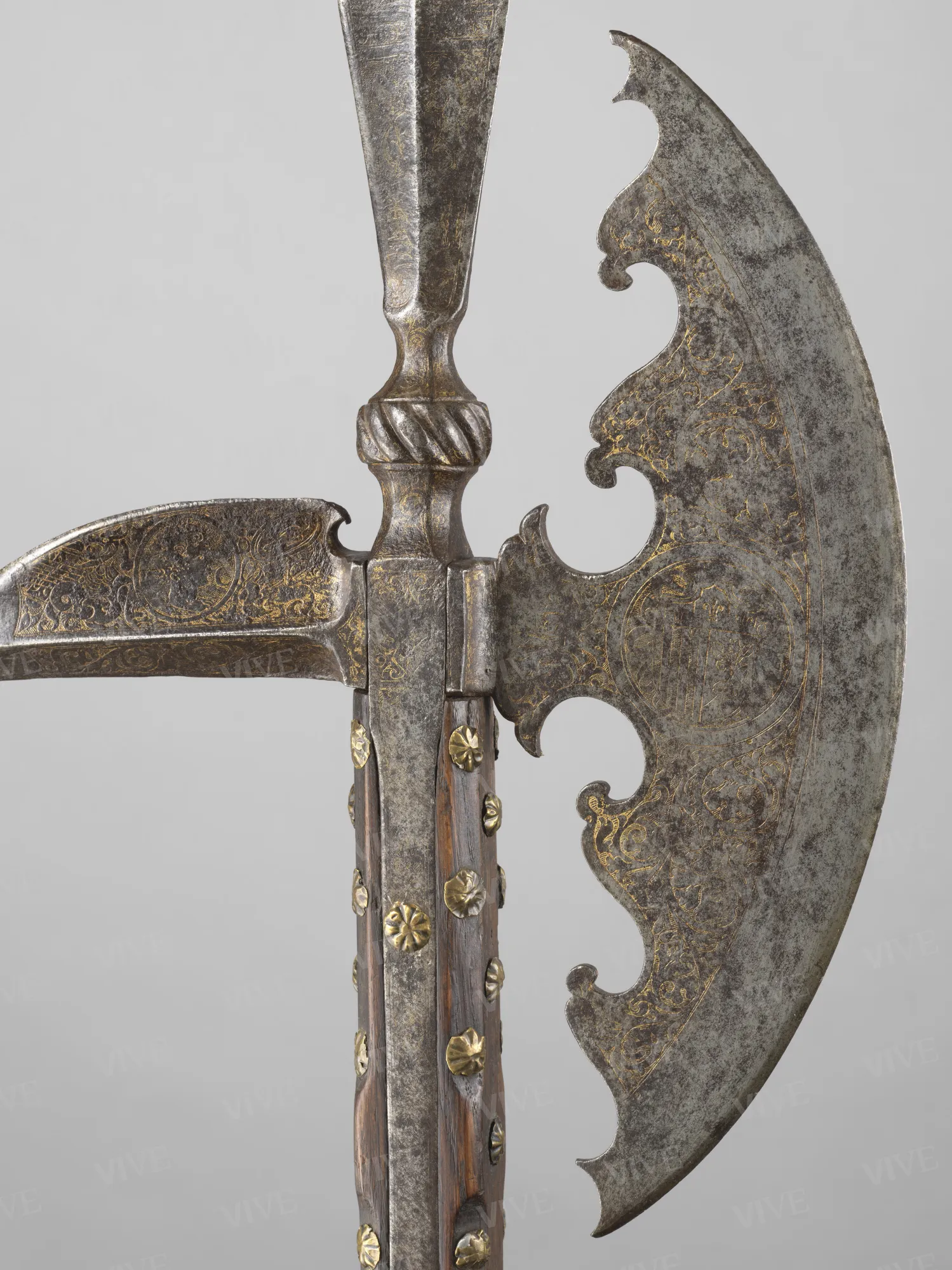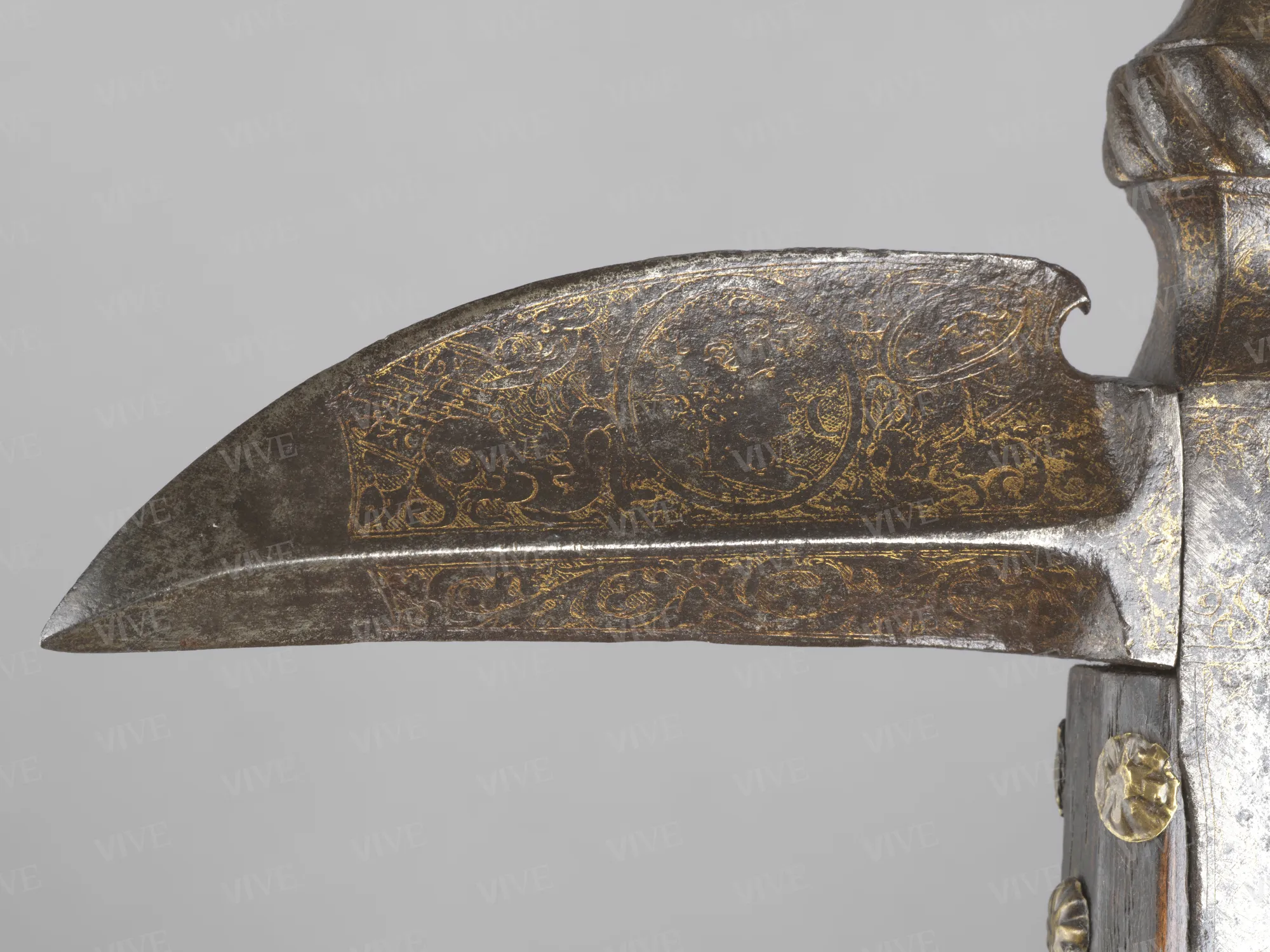Mazzapicchio or azza
Venetian production 1490–1520
Particularly suitable for naval battles, because it was useful for hooking and cutting the rigging of enemy ships, the mazzapicchio, or azza, was a combat weapon equipped with a sharp axe, a cusp and a hawk’s beak. This finely crafted example is decorated throughout (with engraving and gilding), as well as bearing a heraldic coat of arms declaring its ownership.
Particularly suitable for naval battles, because it was useful for hooking and cutting the rigging of enemy ships, the mazzapicchio, or azza, was a combat weapon equipped with a sharp axe, a cusp and a hawk’s beak. This finely crafted example is decorated throughout (with engraving and gilding), as well as bearing a heraldic coat of arms declaring its ownership.
Details of work
Catalog entry
The mazzapicchio consists of a long wooden rod adorned with copper studs shaped like eight-pointed stars, to which the metal component is affixed. This metal part includes a sharp, crescent-shaped axe with shaped inner edges, from which a rhomboid spear-shaped cusp rises, featuring a knot at the bottom crossed by diagonal lines. Adjacent to the axe is a thick, triangular tooth resembling a hawk's beak (di Carpegna 1969, p. 62, n. 368; di Carpegna 1976, p. 62). With the exception of the topmost portion of the cusp, the entire metal component is engraved and gilded. On the tooth, amidst plant motifs and shields, there is a roundel depicting a head in profile styled after ancient art, flanked by the letters "SC" reminiscent of Roman coins. The axe features an engraving of a large heraldic coat of arms within a clypeus and accompanied by a ribbon curled around the shield. It is divided into two parts: a three-piece pallet on the left side and a hand holding an oak branch on the right side. At the center of the crest is a fleur-de-lis.
The mazzapicchio is a bladed weapon that originated in the Middle Ages and features three points and blades, designed for striking, cutting, and harpooning. Similar to the azza, it is also known as a "bec de faucon" (hawk’s beak) or scure d’armi. This weapon evolved particularly during the fifteenth century, when weapon makers managed to reduce its weight and enhance its maneuverability, while maintaining its effectiveness in combat (Waldman 2005, pp. 155–164; Oakeshott 2012, pp. 49–51).
This weapon was commonly utilized on Venetian galleys due to its effectiveness in hooking onto and severing the rigging of enemy vessels. Numerous specimens, which feature the engraved lion of Saint Mark, are preserved in several notable collections, including the armory of the Doge’s Palace in Venice (Scalini 2018), the Metropolitan Museum in New York (Grancsay 1955, p. 19, n. 55), and the Wallace Collection in London (Mann 1962, p. 457).
Due to the absence of a gunsmith’s mark and the inability to trace the heraldic coat of arms to a specific family, it is not possible to precisely attribute this polearm to any particular workshop. Therefore, the weapon can tentatively be associated with Venetian craftsmen who produced similar items during the fifteenth and sixteenth centuries (Scalini 2018, p. 234, n. VIII.9).
There are documented instances of the weapon being acquired prior to its purchase by Ladislao Odescalchi (1846–1922). The mazzapicchio became part of his collection in 1897, after it had been in the possession of Richard Zschille, whose other items are now housed in the Cleveland Museum of Art, and Charles Alexander, Baron de Cosson (Cripps Day 1925, p. 107; Barberini 2007).
Giulia Zaccariotto
Entry published on 27 March 2025
State of conservation
Good.
Coats of arms, emblems, and marks
On the beak, on either side of a head in profile in a roundel, “S[enatus] C[onsultum]”; on the axe, a coat of arms.
Provenance
Collection de Cosson (Christie 1893, no. 142);
Richard Zschille collection (Christie 1897, no. 335);
Collezione Ladislao Odescalchi (Odescalchi, no. 441);
acquired by the Italian State, 1959;
Rome, Museo Nazionale di Palazzo Venezia, 1969.
Exhibition history
Rome, Museo Nazionale di Palazzo Venezia, Antiche armi dal sec. IX al XVIII. Già Collezione Odescalchi, May–July 1969;
Rome, Museo Nazionale di Palazzo Venezia, Belle e terribili. La collezione Odescalchi. Armi bianche e da fuoco, December 18, 2002–March 23, 2002;
Gardone Val Trompia, Museo delle Armi, Armi antiche a Gardone, September 29, 2007–February 29, 2008;
Rome, Museo Nazionale di Castel Sant’Angelo;
Rome, Museo Nazionale di Palazzo Venezia, Armi e potere nell’Europa del Rinascimento, July 26–November 11, 2018.
References
Christie, Mason & Wood, Armour and Arms, London 1893;
Christie, Mason & Wood, Catalogue of the Collection of Armour and Arms and Hunting Equipments of Herr Richard Zchille, London 1897;
Cripps Day Francis Henry, A Record of Armour Sales (1881-1924), London 1925;
Grancsay Stephen Vincent, Loan Exhibition of Mediaeval and Renaissance Arms and Armor from the Metropolitan Museum of Art, catalogo della mostra (Washington,Washington County Museum of Fine Arts, 27 febbraio-31 marzo 1955), Hagerstown 1955;
Mann James Gow, European Arms and Armour. Wallace Collection catalogues, 2 voll., London 1962;
di Carpegna Nolfo (a cura di), Antiche armi dal sec. IX al XVIII. Già Collezione Odescalchi, catalogo della mostra (Roma, Museo Nazionale di Palazzo Venezia, maggio-luglio 1969), con schede a firma del curatore, Roma 1969, p. 62, n. 368;
di Carpegna Nolfo, Le armi Odescalchi, Roma 1976;
Barberini Maria Giulia (a cura di), Belle e terribili. La collezione Odescalchi. Armi bianche e da fuoco, catalogo della mostra (Roma, Museo Nazionale di Palazzo Venezia, 18 dicembre 2002-23 marzo 2002), Roma 2002, p. 36;
Waldman John, Hafted Weapons in Medieval and Renaissance Europe: The Evolution of European Staff Weapons between 1200 and 1650, Leiden 2005;
Barberini Maria Giulia, La collezione Odescalchi di armi antiche: storia della raccolta del principe Ladislao, in «Bollettino d’arte», s. VI, XCI, 2006 (2007), 137/138, pp. 101-114;
Fossà Bianca, Studio conservativo delle armi e armature Odescalchi. Nuove metodologie per la schedatura di una collezione, in «Bollettino d’arte», s. VI, XCI, 2006 (2007), 137/138, pp. 115-142;
Calamandrei Cesare (a cura di), Armi antiche a Gardone. Mostra inaugurale del Museo delle Armi e della Tradizione Armiera di Gardone Val di Trompia, catalogo della mostra (Gardone Val Trompia, Museo delle Armi, 29 settembre 2007-29 febbraio 2008), Brescia 2007, p. 175, n. 90;
Oakeshott Ewert, European Weapons and Armour. From the Renaissance to the Industrial Revolution, Woodbridge 2012;
Scalini Mario (a cura di), Armi e potere nell’Europa del Rinascimento, catalogo della mostra (Roma, Museo Nazionale di Castel Sant’Angelo; Roma, Museo Nazionale di Palazzo Venezia, 26 luglio-11 novembre 2018), con schede a firma del curatore, Cinisello Balsamo 2018, p. 234, n. VIII.9.

